My favorite part about my role in ecology and land management is going out to see how a prairie community is responding to management or restoration activities. I’ve fought hard to keep work that in my job description, even though I’m no longer an active land manager for The Nature Conservancy. I’m still involved in discussions of management plans, and I get to assess the results of those and see how the plans played out. (I also help with burns and chip in with other work now and then.)
Of course, I do get to manage our little family prairie, which lets me have full control over the management of at least one site! While I like having that direct responsibility on our 160 acres, I’m also fine with letting others deal with the day-to-day invasive species and other challenges at a larger scale. It’s more pleasant these days to cut trees or fix fence when I feel like it instead of as a full time job!
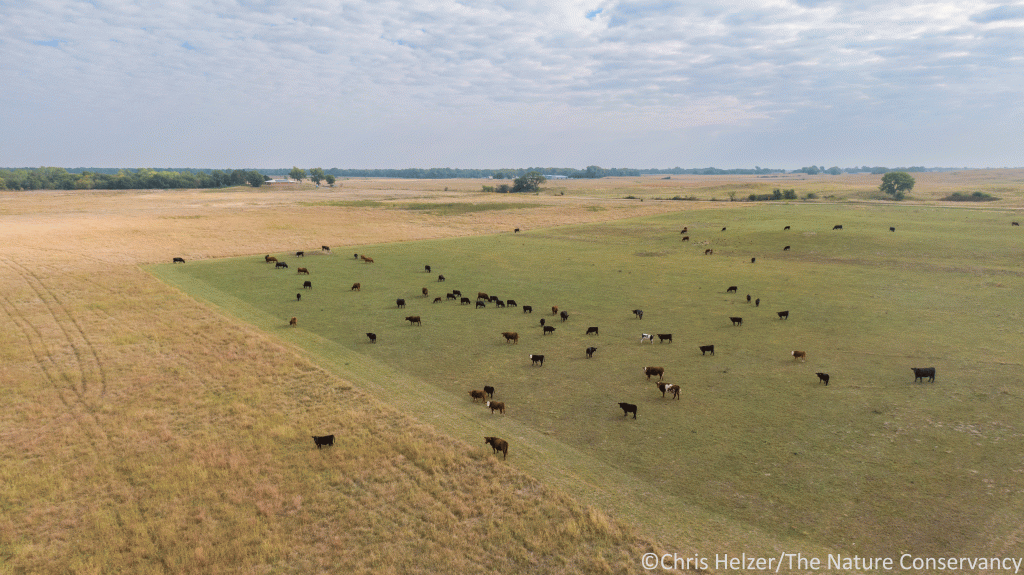
I really love being able to watch and learn from the adaptive management cycle (develop an idea, try it out, see how it went, adjust the strategy). During long drives, or in other quiet moments, my brain starts running through various land stewardship scenarios. I have a lot of “I wonder what would happen if” discussions with myself. Those internal dialogues would be less effective if I wasn’t frequently out on the prairie and seeing the results of all the different tactics being tested on our sites.
Yesterday, I spent part of a day looking at several management units at the Platte River Prairies. I knew what Cody’s (preserve manager) long-term and annual objectives were for each site, so that gave me a basis to work from. I thought I’d share some of the photos and notes I took with you, in case they’re of interest. For those of you hoping for more photos of dew-covered dragonflies or waiting for the results of my annual obsession with photographing milkweed seeds, I apologize. Maybe next week.
I won’t cover all the sites I visited, but I figured I’d include the two prairies where we conducted summer fires back in late July. Those are good opportunities to learn about a practice that’s still experimental for us and I’ve heard from a number of you about this topic.
I’ll start with our “Miller Tract”, which is a remnant prairie that had lost considerable plant diversity prior to our acquisition of it. We’ve overseeded portions of the site over time, and that has helped, but the plant community isn’t where we want it yet. Still, it’s a neat site, with some crazy soil-related patchiness, lekking prairie chickens in the spring, and some cool sedge meadow swales.

Cody wanted to burn a small part of this site to attract cattle grazing and provide some more variety in the habitat structure of the site. The prairie is being managed with patch-burn grazing, though with considerable modification to meet annual objectives. When we conducted the summer fire, cattle already had access to a larger patch we’d burned back in the spring, and had been grazing that pretty hard.
Adding more burned habitat, we thought, would pull some of the grazing intensity off the spring burn. In addition, the summer burn patch had been only lightly grazed in recent years and was getting pretty dense and thatchy before the fire, so both plant growth and habitat quality for most animals was decreasing. There wasn’t much woody encroachment in the patch, so Cody wasn’t worried about suppressing trees or shrubs with this particular burn.
After the fire, cattle did start grazing the summer-burned patch pretty intensely, while continuing to graze in the spring-burned area. Several weeks after the burn, Cody moved cattle out of the prairie to get some grazing pressure on an adjacent site. That gave plants in both the spring and summer areas a chance to grow a little bit before the end of the season.

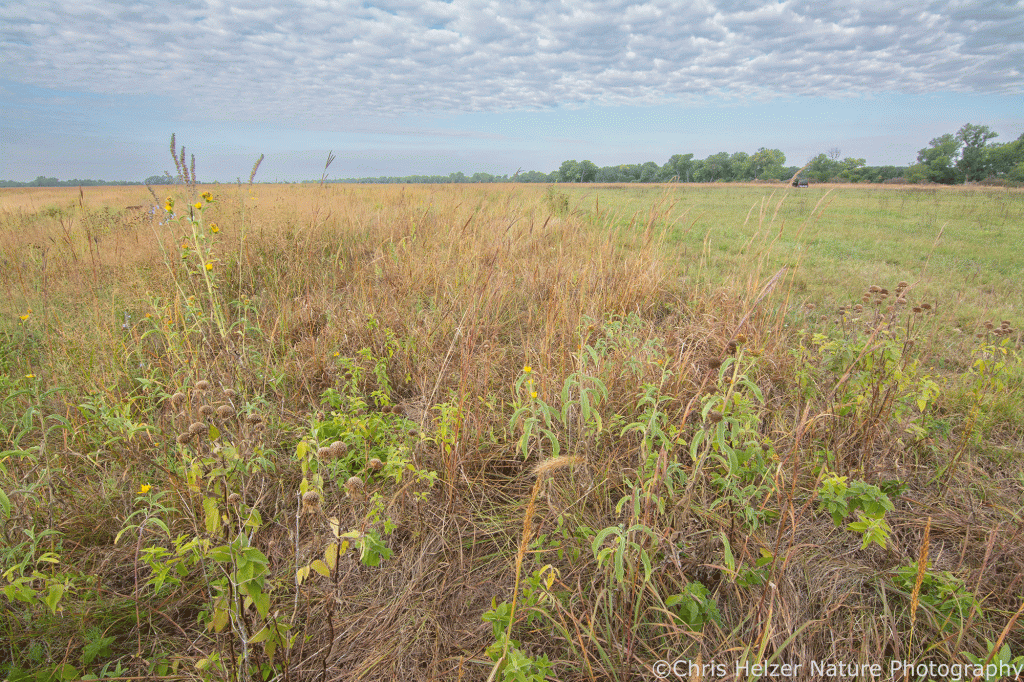
Cody definitely got the habitat heterogeneity he was shooting for with the summer burn. We’re not collecting data on animal use of that habitat, so we’re making assumptions that the increased variety of habitat options helps accommodate the needs of lots of species. That seems reasonable, based on both logic and the research that’s available to us. Still, it’s something I want to keep studying whenever we get funding and opportunities to do that.
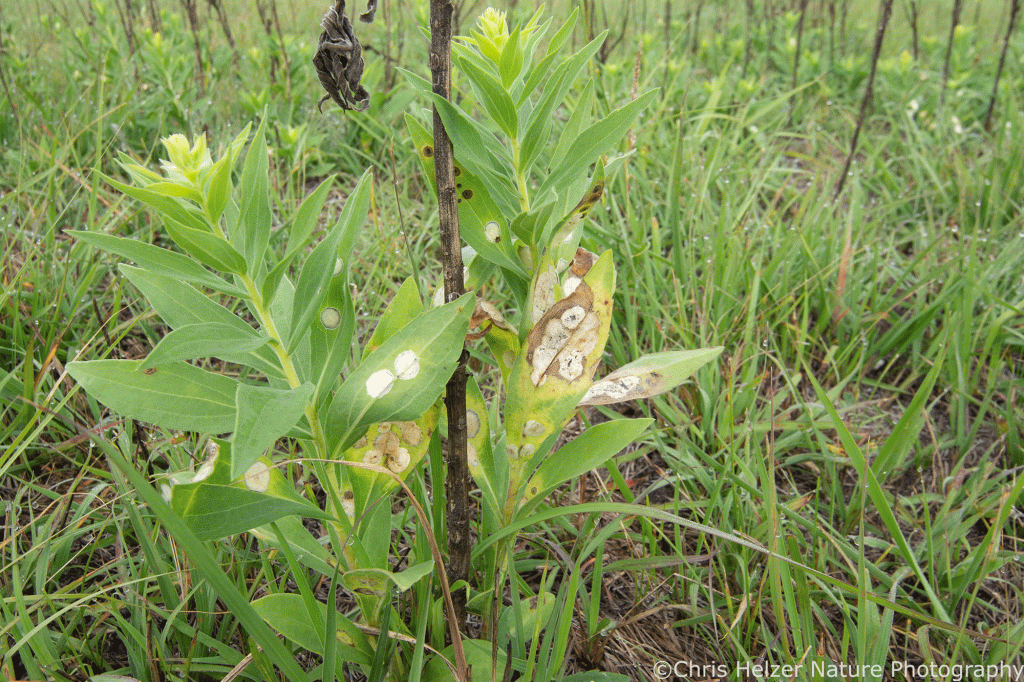
One fun little observation sent me on an online trail after I got home. I noticed that the leaves of Canada goldenrod plants in the summer burn were loaded with little leaf galls. I wrote about the incredible story of these galls last year, but I was surprised they’d been formed so late in the season. I had thought the galls were formed by the little fly laying eggs early in the summer, but after doing more reading, I realized there are often several generations of the fly each year. Now it makes sense that the galls could have formed on leaves that grew after the July burn.
However, the density of galls still seemed really high. It might be coincidence, but it sure makes me wonder if the fly species was particularly attracted to these goldenrod plants because of the burn. I don’t have a good guess for why that would happen, but it’s definitely something I’d like to pay more attention to in the future.
After leaving the burned area, I went to the far west end of the Miller Tract to look at an area we’d overseeded a dozen years ago, or so. I was curious to see if the diversity of wildflowers was being sustained. Visually, at least, the news seemed good. I might go back next summer and repeat some sampling transects I’d used back in 2011-2013 and see if I can get some actual data to check against my observations.
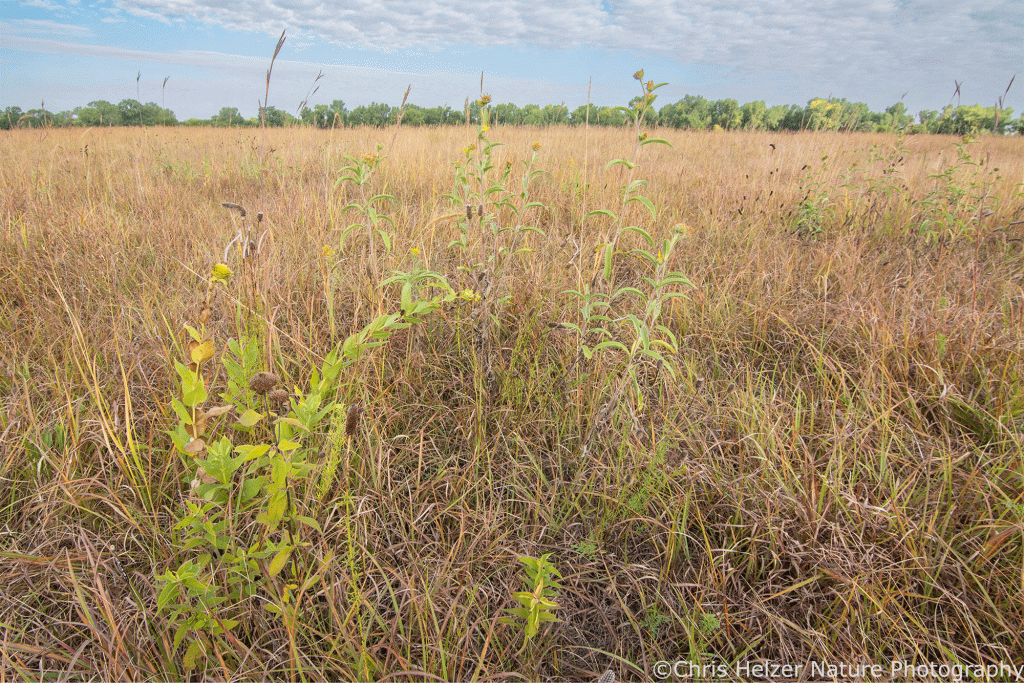
The tract of land adjacent to the Miller Tract is an old farm field that was planted to low-diversity prairie long ago and then overseeded with a few native wildflowers before we acquired it. It has a long way to go before the plant community is what we want, but it still provides great habitat for a lot of animals. It’s also the site of the spring burn I mentioned earlier, and cattle were using both the Miller Tract and this one simultaneously.
The drought definitely kept vegetation heights shorter than normal on the unburned half of this piece, but there was still decent cover for animals that like that kind of thing. In contrast, the spring burn had been grazed hard and was short (and much greener). Both the burned and unburned areas had a lot of Maximilian sunflower and Canada goldenrod flowers to help keep pollinators and other insects happy.


Another thing I’d like to study is the effect of the late-season lush green vegetation in summer burns on herbivores other than big grazers. In particular how much do grasshoppers, leaf hoppers, and other invertebrates use summer burned areas differently in late summer and fall when most other vegetation is senescing? Is that availability of active green growth of any significant value? It seems likely, but I’m just basing that on educated guessing.
I also visited the site of the other summer burn we conducted back in July. The photo below, as well as the first one in this post show that burn and the cattle that are happily grazing it. This is a restored prairie planted with a seed mix of over 200 plant species back in the year 2000. It’s a nice prairie, but where the summer burn took place, it had been mostly idle (no fire an only very light grazing) for several years and was looking pretty grassy and dull.
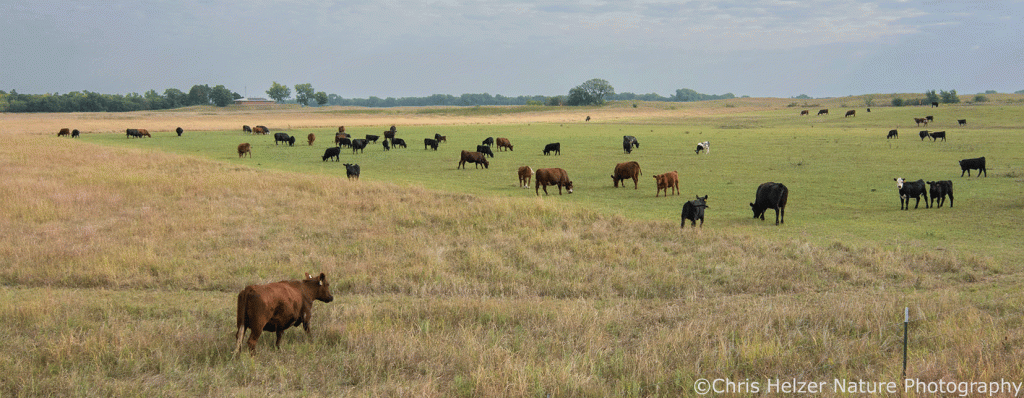
Cody hoped the summer burn would provide the same kind of habitat heterogeneity as the one I’ve already discussed, but also that it would be a good way to set grasses back and allow more forbs to show off. In this case, there were no cows grazing this part of the prairie in 2023 until after the burn. Then Cody opened the gate between this and the adjacent prairie and let cows spread across both sites. They did, and have focused much of their grazing on the summer burn ever since.
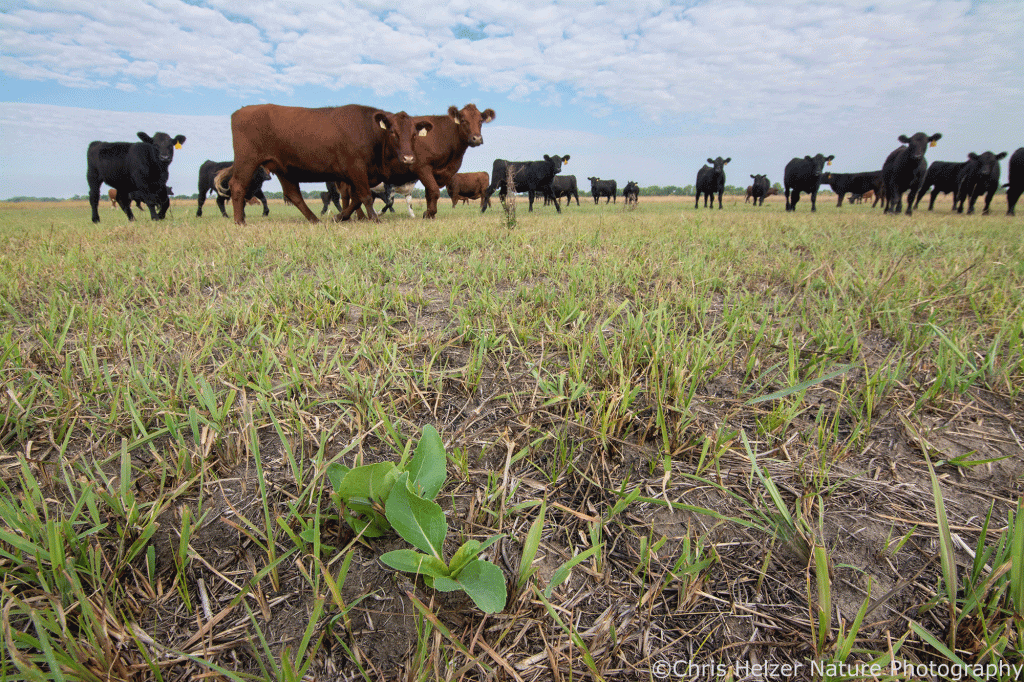

We’ll have to wait until next year to really assess how well the burn and grazing affect wildflower abundance. The hope is that the combination of summer fire and grazing will suppress the growth and competitiveness of the big grasses and open up more space for those other plants.
The combination has worked well on other sites, so we’re optimistic, but I’m still impatient to see the results here. It’s one of my favorite restorations, aesthetically speaking, but isn’t demonstrating that right now because it hasn’t had much disturbance lately. I’m hoping for a dramatic show next year, especially because it’s part of our public hiking area. It would be great to have a sharp contrast line between unburned dense grass and a big flower party in the burned/grazed portion.
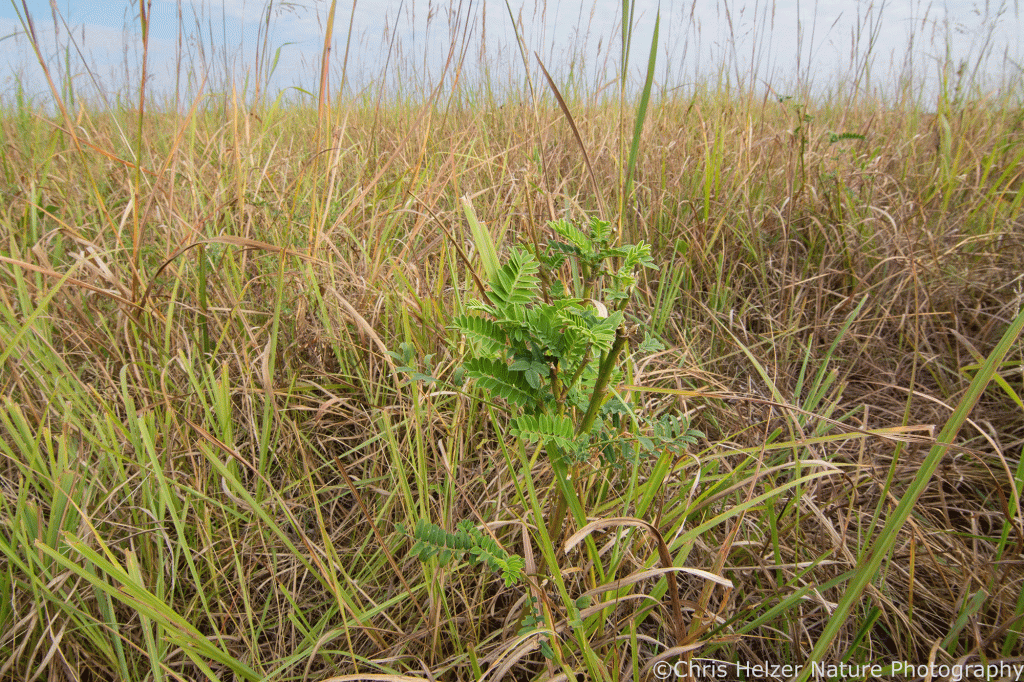
The last site I looked at is our open gate grazing experiment. This is a project where we’re tying to create similar habitat to what we get from patch-burn grazing. The open gate approach, though, uses fences instead of fire to drive grazing pressure. You can read more about it at this link if you want.
I’m collecting data on the plant community impacts and working with a soil scientist to look at what’s happening belowground. Those results are looking good, but I want a few more years to be sure of the trends. In the meantime, I’ve been really happy with the habitat heterogeneity. It’s also a great site to show people how prairies recover from intensive grazing because we can easily point to the places where cattle are currently grazing, as well as places in various stages of recovery. The rest of the photos here show those same stages.

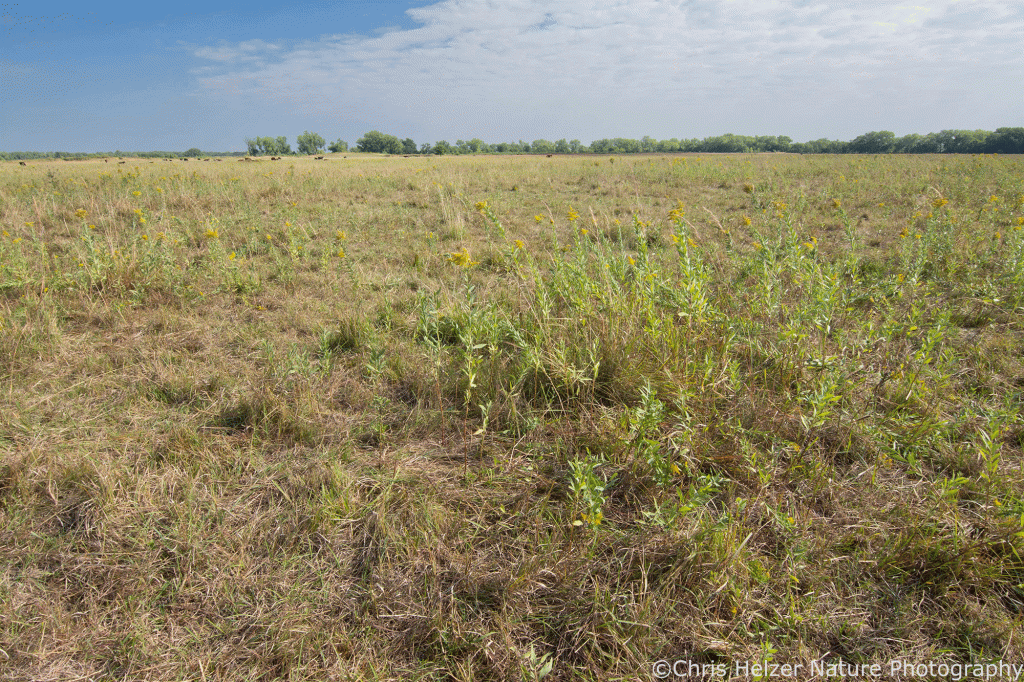



It’s probably a good sign that I’m still excited by the opportunity to check out the results of land management each year. It’s especially fun to look at sites I’ve been watching for almost 30 years now, and that I managed for a good chunk of that. I created some prairies from the ground up, and worked really hard to bolster plant diversity and habitat quality on others. Land stewards after me built upon my work and most of the sites are either in better shape, or at least look as good as they did when I transitioned into a more advisory role.
The sense of pride I get from seeing positive change is part of why I like annual evaluations, but the greater joy really comes from the opportunity to learn. We continue to adapt our approaches each year because we keep coming up with new ideas and testing them. Some of those ideas become adopted as common practice because they prove themselves to be valuable. Others teach us even more because they didn’t produce the results we’d hoped for. And, most importantly, there’s so much variation from site and site and year to year that we still don’t know how some ideas will pan out in the long run.
I’m really fortunate and grateful to be in a position in which I’m encouraged to be creative and experimental, and to be able to support others to do the same. Setting up the experiments is really fun. Evaluating the results, though… that’s what keeps me coming to work every day.

It’s such a pleasure to see these photos and read your observations and thoughts about these management methods you all are testing. These sites have the advantage of being owned and managed with the opportunity for burns and grazing throughout the season.
We have land enrolled in USDA ‘s Conservation Reserve Program (in western WI). This federal program has seasonal limitations on when certain management activities can be conducted – no activity during bird nesting season (between May 15 and Aug 15), and a requirement every 5 years of either a prescribed burn (in spring only) or now a mow (in fall only). I’m only just no learning that mowing and baling can be allowed, if approved well in advance, but otherwise no duff is supposed to be removed after mowing. Quite a few rules to sort though as we try to up the heterogeneity in our management methods… : )
Are you aware of any folks working specifically with CRP landowners to improve their diversity of their prairie plantings, within CRP management constraints? I’d sure appreciate any leads!
Hi Carolyn,
Thanks for those kind words. Yes, CRP has a lot of restrictions. For help navigating that, I’d suggest contacting a farm bill biologist. I’m not very familiar with the options in Wisconsin, but this website might give you a good place to start: https://dnr.wi.gov/files/pdf/news/fbb_map.pdf
Those biologists are usually familiar with the rules and how to work within/around them. If you tell them what you’re trying to accomplish, they’ll hopefully be able to help guide you. My biggest advice would be to enter that conversation with as much clarity as possible about what you’re trying to do. Are you hoping for better pollinator habitat? Plant diversity? Aesthetics? Grassland birds? Hunting habitat? The more specific you are, the better they’ll be at helping you. Also, some of them may have their own objectives that they’ll suggest. Make sure they don’t talk you into something that’s different from what you want, but their ideas might be helpful too, especially if they’re something you hadn’t thought about before.
Good luck!!
Thanks so much for this reply, Chris! Our region’s person on this map is a new name and title to me, and I’ll be tracking this person down with my many questions! Native plant diversity has been our biggest goal, as we hope that as we get that, it’ll provide lots of habitat diversity for other living things.
This was an interesting and useful post!